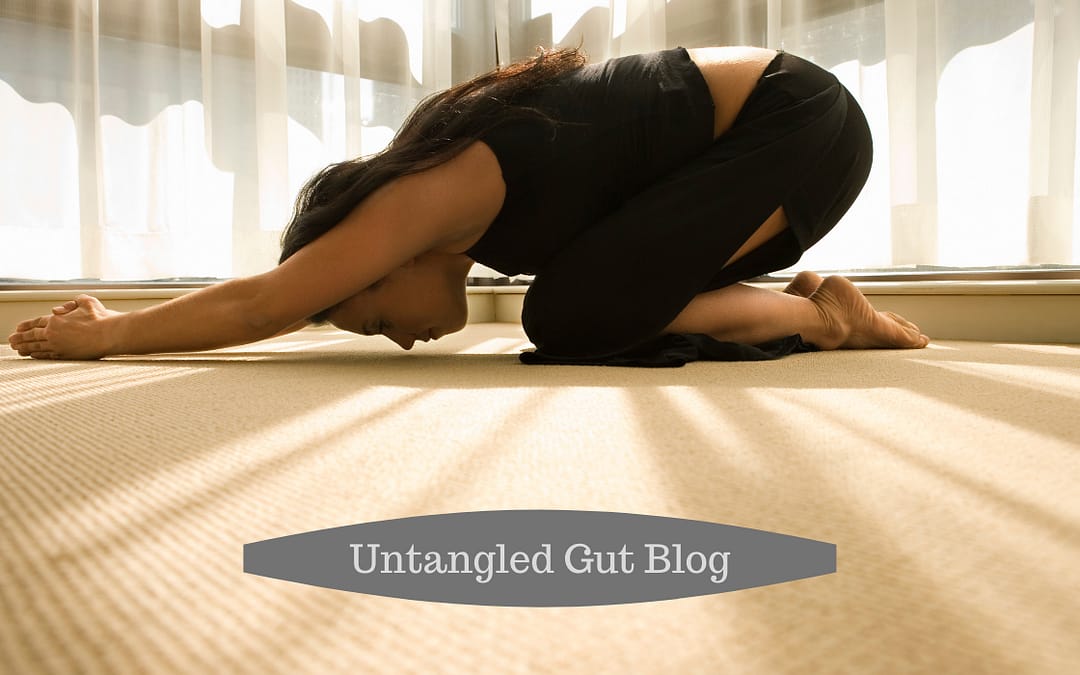How To Use Yoga for IBS? 3 Outstanding Poses Explained
If you are living with IBS (Irritable Bowel Syndrome) and digestive upset, you have probably tried countless suggestions to find relief from debilitating symptoms. Perhaps you have heard from others that yoga can be used as part of a strategy to improve digestive wellness and are curious about how exactly yoga can help your IBS. I hope this post, and future blog posts clarify how and why yoga can be used for IBS.
What is IBS?
IBS affects an estimated 45 million people in the United States. This number could be even higher since IBS is difficult to diagnose because it is a disorder of bowel function rather than abnormal bowel structure.
IBS is characterized by chronic abdominal pain, digestive distress, abnormal bowel movements and muscular spasms of the digestive tract. It sounds pretty miserable, and it is. The unpredictable symptoms can wreak havoc on a person’s lifestyle. The disorder can make it impossible to stick to any kind of schedule.
The ever changing type and severity of symptoms may cause some to give up on the idea of exercise or fitness. Luckily, yoga is a movement practice that can actually help IBS sufferers relieve discomfort. Yoga may be the perfect starting point if you are looking to improve your physical and mental health.
But how is this possible???
Yoga for IBS?
It may seem too good to be true, but gentle yoga poses can be used to relieve certain IBS symptoms, including gas and bloating. This is reason enough for some to give yoga a try, but it gets even better! The most effective benefits of yoga for digestive health take advantage of how this ancient science masterfully reduces stress and connects you to what is happening in your body in the present moment.
Stress and anxiety are extremely common triggers that can lead to an IBS ‘flare-up’ (period of symptom worsening). This makes sense when we consider the importance and complex nature of the ‘brain-gut axis’. We have all experienced this connection when we sense ‘gut feelings’ about situations or get butterflies in our bellies when we are nervous.
Unfortunately, IBS seems to involve some sort of miscommunication between our nervous system and our digestive tract. In other words, our brain-gut axis has been disrupted. The nerves of the gut become oversensitive and can overreact to changes in our physical and emotional states. Keep in mind that the gut-brain axis is a two-way street. As a result, it is not always clear if chronic digestive dysfunction creates the higher levels of anxiety or the other way around.
However, one fact is clear. If we can decrease stress levels by calming the nervous system with yoga postures and breathing, we can also calm an irritated gut and shift towards a healing state.
A regular yoga practice can also help you tune in to sensations in the body and develop a better sense of cause and effect for your body. These connections make you more aware of patterns in your body’s responses to certain foods or habits that might be making your symptoms worse. Learning what these triggers are and responding to them earlier can help you avoid bouts of IBS altogether. And this means more symptom-free time!
Poses you can try now:
Want to start reducing your emotional and physical symptoms of IBS? Let’s look at 3 yoga postures that can be used as part of a longer sequence, or on their own. These poses were chosen for their ability to soothe digestive symptoms, release tension in your abdomen, lower stress levels and allow you time and space to communicate better with your body. While moving into and holding the poses be sure to maintain a focus on steady, smooth breathing.
Grab a mat and give these a go!
Wind-relieving pose:
Fitting name, right? And it lives up to it. Try this pose anytime, and especially if you are feeling gassy or bloated. It can provide instant relief.
- Lie on your back with legs extended and your arms at your sides.
- As you exhale, draw both of your knees to your chest and clasp your hands around them, giving them a slight hug in towards your abdomen.
- Keep hold of your right leg and release your left leg back down to the ground and extend it out long. Gently press your lower back against the ground.
- Hold this pose as you breathe slowly and deeply (aim for 5 breaths). Try to keep your knee in line with your body, not at an angle across the body.
- Bend your left knee to your chest and give both knees another squeeze towards your abdomen before switching sides and releasing your right leg to the ground as you breathe evenly for 5 more breaths.
- After you’ve held the pose with your left leg bent, pull both legs in again for a breath before releasing them both down.


Child’s pose (balasana) variation:
- Start on hands and knees. Bring your big toes to touch and separate your knees a comfortable distance apart. You might find that having your thighs/knees a little closer together makes this variation more effective. Feel free to experiment and find what works best for your body and your symptoms!
- Before lowering into traditional child’s pose, make fists with your hands and place them against your lower belly (knuckles facing your abdomen). Refer to the picture below.
- On an inhale, grow tall through your spine, imagining that you are creating space along your entire spinal column.
- On an exhale, move your hips back towards your heels and allow your forehead to rest comfortably on the floor or a block or blanket placed in front of you. Your torso will rest between your thighs or on the thighs, depending on the distance you have between the knees. Your fists will be applying light pressure to your abdominal region.
- Bring your awareness to your belly and release tension there while focusing on your breathing (5-10 breaths).
- If you find it helpful to your symptoms, gently and slowly move the fists to other areas of the belly or use the fists to ‘massage’ the low belly.


High lunge twist:
- Come into a high lunge position on the ball of your back foot, with your feet about hip-width apart and parallel to the long edges of the mat.
- Open your arms up into a goal post position with palms facing forwards.
- From this position, turn the belly into a twist by rotating the torso towards the thigh of your front leg.
- Remain here for 3-5 full breaths before unwinding from the twist and stepping the back leg to the front of the mat.
- Repeat the above steps on the second side.


I hope you are able to find time to add these poses into your day if you are suffering with digestive symptoms such as bloating, pain and distention. Feel free to leave any questions about these poses or other comments below. Also, always check with your health care provider before starting any new fitness routine.
I use these postures in addition to others as part of my own fitness routine when my IBS and SIBO (small intestinal bacterial overgrowth) symptoms flare up. I find that they do help ease discomfort, lower my anxiety and improve my overall outlook.
You can read more about my journey with IBS and SIBO in a recent blog post.
Interested in even more ways you can calm your IBS flare-ups? Be sure to download my FREE guide that describes 5 ways you can better manage your stress to decrease your IBS symptoms. Just click the image below for more information.




I love this! I knew yoga was very beneficial but I didn’t realize how much so for IBS and other digestive disorders. This is great for anyone suffering from these terrible symptoms.
Thanks for your feedback! It is my hope that more and more people suffering with digestive disorders find some relief with strategies like yoga.